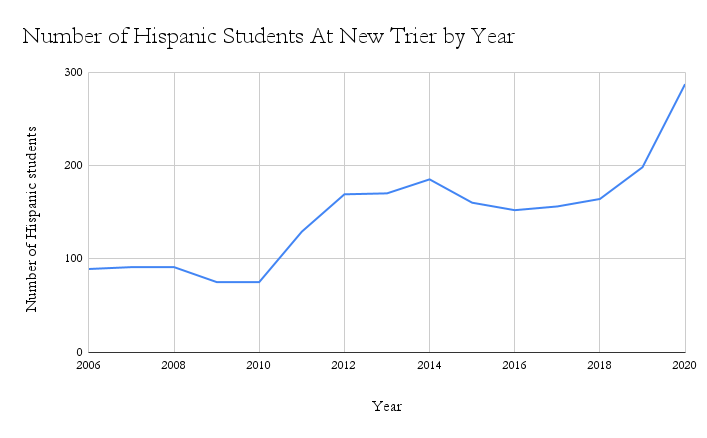New Trier sees rapid increase in Hispanic diversity
After years of wavering demographics, last couple of years show substantial growth
The New Trier High School Report Card is showing a record number of Hispanic students attending the school in the 2020 school year. This increase is most notable considering for the years before 2018, the number of Hispanic students were increasing slowly with highs and lows.
This rise in numbers only started to be apparent in the 2018-2020 years with 4% of students identifying as Hispanic in 2018 (159 students), 4.9% in 2019 (198 students), and finally 7.1% in 2020 (287 students).
Other racial demographics are also changing, though less significantly. White students have been slowly decreasing, making up 83.8% in 2017 (3357 students), 83% in 2018 (3293 students), 79.7% in 2019 (3205 students), and 77.9% in 2020 (3148 students). Asian students have been increasing, albeit at a slower rate than Hispanic students: 7.8% in 2017 (312 students), 8% in 2018 (317 students), 9.4% in 2019 (377 students), and 9.6% in 2020 (388 students).
Despite the increase of Hispanic students in the district, other schools in the area have been more constant in their Hispanic populations. Glenbrook South High School has had 13% of students identify as Hispanic between the years 2016 and 2020 with the exception of 10% in 2019. Stevenson High School had 8% of students identify as Hispanic between the years 2016 and 2020 except for 7% in 2017. And Evanston Township High School had 18% in this four year timespan except for 19% in 2020.
To put these numbers into context, the rest of the country has also had a slowly increasing Hispanic population. According to the US Census Bureau, the Hispanic population in the USA was 57.4 million in 2016, 58.85 million in 2017, 59.76 million in 2018, and 60.48 million in 2019; the population of Hispanics specifically in Illinois in 2016 were 2.179 million, 2.207 million in 2017, 2.209 million in 2018, and 2.216 million in 2019.
So what is behind these increases? One theory, according to Associate Superintendent Chris Johnson, is due to how race is filled out on the census; the existence of a “some other race” category confused a majority of people who didn’t know how to identify themselves. In the 2010 Census, 18.5 million people out of the 19 million people who checked off “some other race” were Hispanic. So, to better represent everyone, a combined option for race and ethnicity was created in 2014.
“In 2014, the way that Hispanic and Latino was reported changed for the United States Census, and subsequently for the state and schools,” said Johnson.
A more local reason is also due to the change in ways families would verify their data. Instead of using paper forms to ask for student demographic data, in the 2017-2018 school year, the school transitioned to an electronic version that was required for all families.
“More people subsequently may have reviewed the section about race/ethnicity and updated it than before,” said Johnson.
Hispanic representation at New Trier has been highlighted this year especially with events coordinated like Hispanic Heritage Month, where posters of Hispanic artists, activists, musicians, and influential people are on display around the school along with special presentations on Hispanic culture and identity.
“We’ve helped put together many of the displays that are around the building,” said Maria Barraza, sponsor of the LatinX Affinity Group. “I’m hoping that in future years as we continue to observe the different groups throughout the year we have more momentum and more student participation.”







































